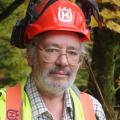
THE AHWI RT400 has built itself a reputation over the decades as one of the most effective and efficient tracked implement carriers for vegetation management.
It is hard to deny that the power and reliability of the RT400 in dealing with the toughest of vegetative growth – wood fibres in all their forms – has elevated the German-built machine to become the benchmark in the sector.
In certain scenarios, a lighter, less powerful combination may fit the bill. If the work is intermittent, a wheeled carrier may be able to supplement its keep on agricultural duties. For a more powerful option, the top-of-the-range AHWI Raptor 800 may be the most suitable choice. There are heavier machines from other manufacturers that, on paper, deliver a heavier punch, but when comparisons are made, the AHWI RT400 is still considered by many contractors to set the industry standard.
AHWI Maschinenbau GmbH was founded in 1990 by Artur and Hubert Willibald to produce attachments for land clearance and solid waste processing. The first crawler implement carrier appeared in 1994 and the business relocated to its current site at Herdwangen in southern Germany a couple of years later.

The company’s patented rotor and tool concept had been well received by the industry. Forestry clearance work was becoming a full-time occupation for many contractors and there was an ever-increasing demand for AHWI’s dedicated tracked tool carriers. Expansion of the production facilities continued in the first decade of the 21st century.
A partnership with special vehicles producer Prinoth, based in the Italian Alps, was initiated in 2011. The racing driver and engineer Ernst Prinoth had produced the first successful ‘snow groomer’ in 1964 in the vehicle repair workshop he had set up in Val Gardena. The business was in the right place at the right time. Prinoth vehicles were soon to be seen across the globe as ski resorts developed in the mountain ranges of every continent.
Prinoth’s move into vegetation management was completed in 2016 with the full acquisition of AHWI Maschinenbau GmbH by the Italian firm. While the new range of Raptor tracked carriers – the 300, the 500 and the 800 – were now in production, the well-known and highly respected RT400 would remain an option. While the Raptors’ newly designed Power Belt Drive was expected to give the recent generation certain advantages of machine performance, the highly efficient mechanical drivetrain of the RT400’s power take-off shaft remains the preferred operating system for some contractors.

Demand for woody biomass has moved the goalposts when it comes to dealing with harvesting residues. If ‘lop and top’ requires any sort of intervention, it makes good sense to consider converting it into wood fuel. Simple mulching of residues is now rarely the first option, but the occurrence of pests and diseases can sometimes help swing the balance in its favour.
Some years ago, mulching was carried out on clearfelled conifer sites in Kielder Forest district. Restocking costs were reduced, but the key purpose of the experiment was to find out whether the process reduced the populations of large pine weevil significantly. Breeding in freshly cut conifer stumps, the insects emerge to attack the shoots of newly planted seedlings, often causing considerable damage. Unfortunately, the mulching did not turn out to be a very effective method of control.

With landowners taking advantage of buoyant timber prices to clear disease-susceptible species from their woodlands, mulching has become a new weapon in the modern forester’s management toolbox. A Kingwell Holdings AHWI RT400 fitted with a UZM 700 mulcher was recently called in to deal with both the residues and stumps on a clearfelled ash site in the Cotswolds.
Joe Kettle, from Stoke on Trent, was Justin Kingwell’s operator on site and outlined the procedure. The landowner and forestry manager were keen that all saleable timber was forwarded out to the timber landing some distance away. The long extraction and the crossing of agricultural land precluded the forwarding of harvesting residues to the landing and also the possibility of chipping on site.

The clinching argument for mulching, however, was the need to effectively destroy the stumps. Not only would regrowth from the cut stumps be very susceptible to ash dieback disease, but it would severely threaten the survival of the seedlings used in the restocking of the woodland. Mulching of both the branchwood and the stumps offered a viable alternative to chemical treatment and would make the replanting process far easier and simplify the future management of the woodland.



Comments: Our rules
We want our comments to be a lively and valuable part of our community - a place where readers can debate and engage with the most important local issues. The ability to comment on our stories is a privilege, not a right, however, and that privilege may be withdrawn if it is abused or misused.
Please report any comments that break our rules.
Read the rules here